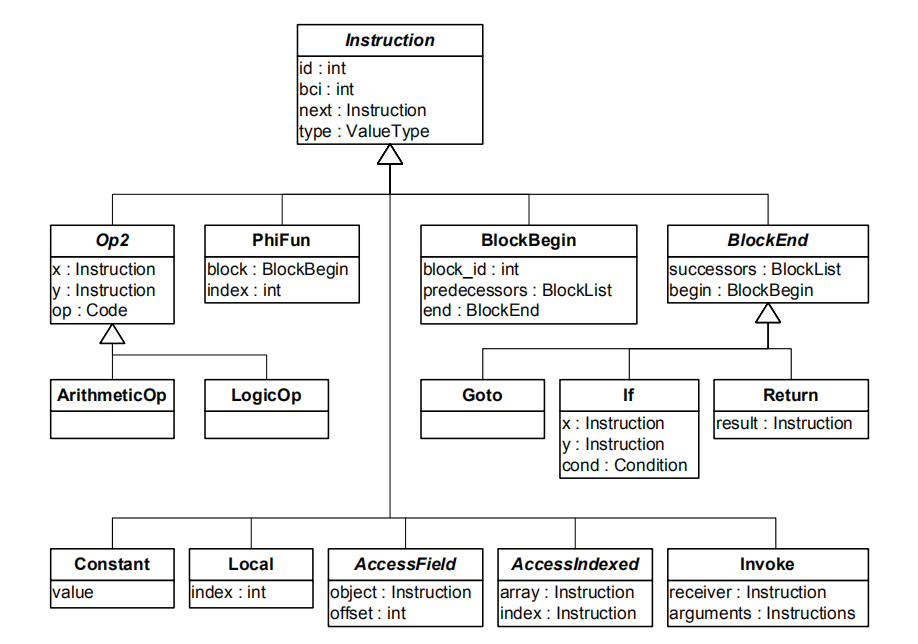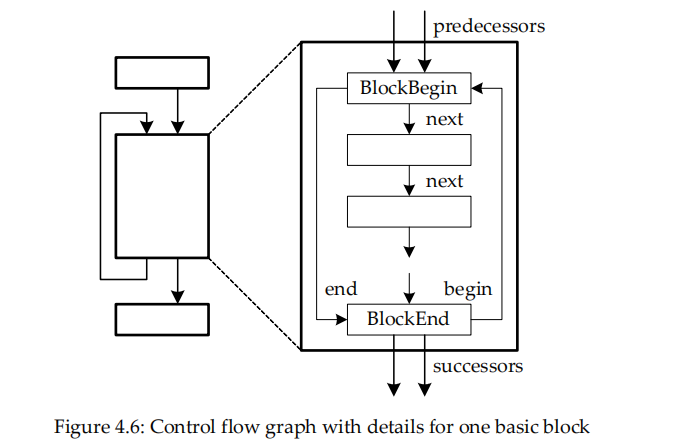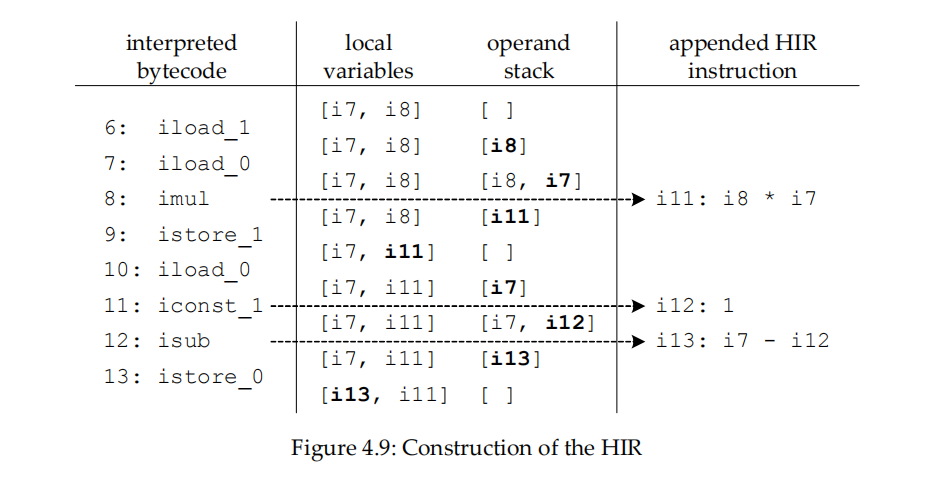1. 简介
这篇文章可以说是Christian Wimmer硕士论文Linear Scan Register Allocation for the Java HotSpot™ Client Compiler的不完整翻译,这篇论文详细论述了HotSpot JIT编译器的架构,然后描述了C1编译器(研究用,细节和Sun的Client编译器生产级实现有些许出入)中线性扫描寄存器分配算法的设计和实现。
C1编译器内部使用HIR,LIR做为中间表示并进行系列优化和寄存器分配。字节码到HIR的构造是最先完成的步骤,其中HIR是一个平台无关的图结构IR,它的构造位于hotspotsharec1c1_IR.cpp,整个源码的层次如下:

上面是不完整的类层次图,列举了最重要的类。所有的指令都是继承自Instruction:
class Instruction: public CompilationResourceObj {
private:
int _id; // 指令id
int _use_count; // 值的使用计数
int _pin_state; // pin的原因
ValueType* _type; // 指令类型
Instruction* _next; // 下一个指令(如果下一个是BlockEnd则为null)
Instruction* _subst; // 替换指令,如果有的话。。
LIR_Opr _operand; // LIR operand信息
unsigned int _flags; // flag信息
ValueStack* _state_before; // Copy of state with input operands still on stack (or NULL)
ValueStack* _exception_state; // Copy of state for exception handling
XHandlers* _exception_handlers; // Flat list of exception handlers covering this instruction
protected:
BlockBegin* _block; // 包含该指令的Block的指针
..
};
2. HIR的设计
BlockBegin表示一个基本块的开始,BlockEnd表示结束,两者有一个指针相连,这样可以快速的遍历控制流图,而不需要经过基本块中间的指令。BlockBegin的字段predecessors表示前驱基本块,由于前驱可能是多个,所以是BlockList结构,BlockList是GrowableArray<BlockBegin*>,即多个BlockBegin组成的可扩容数组。同理,BlockEnd的successors表示多个后继基本块。

基本块除了BlockBegin,BlockEnd之外就是主体部分,这一部分由具体的Instruction子类组成,每个Instruction有一个next指针(见上面源码),以此可以构成Instruction链表。
3. 高观点层次的字节码到HIR构造
在[Inside HotSpot] C1编译器工作流程及中间表示我们提到build_hir()这个函数会执行HIR的构造,HIR的优化。从字节码到HIR的构造最终调用的是GraphBuilder。
GraphBuilder首先使用BlockListBuilder遍历字节码构造所有基本块,然后储存为一个链表结构,即之前提到的GrowableArray<BlockBegin*>,但是这个时候的基本块只有BlockBegin,不包括具体的字节码。第二步GraphBuilder用一个ValueStack作为操作数栈和局部变量表,模拟执行字节码,构造出对应的HIR,填充之前空的基本块:

上图是非常直观的构造过程,上面的local variable和operand stack位于ValueStack里面,当执行iload_1时候,局部变量表的索引1位置的变量i8压入操作数栈;执行iload_0压入i7到操作数栈(下文用栈代替),imul弹出栈顶两个值,然后构造出HIR指令i11 = i8 * i7,然后根据imul的语义生成的i11入栈;istore_1弹出栈的数据保存到局部变量表;iconst_1构造出HIR指令i12 = 1然后压入i12,;isub弹出栈顶做减法,构造出i13 = i7 - i12,将i13压入栈;最后istore_0弹出栈顶i13写入局部变量表。
4. 源码层次的字节码到HIR构造
明白高观点下字节码是如何构造出HIR的,源码层次也变得很容易理解了。ValueStack表示用于模拟字节码执行的操作数栈和局部变量表:
// hotspotsharec1c1_ValueStack.hpp
class ValueStack: public CompilationResourceObj {
public:
enum Kind {
Parsing, // During abstract interpretation in GraphBuilder
CallerState, // Caller state when inlining
StateBefore, // Before before execution of instruction
StateAfter, // After execution of instruction
ExceptionState, // Exception handling of instruction
EmptyExceptionState, // Exception handling of instructions not covered by an xhandler
BlockBeginState // State of BlockBegin instruction with phi functions of this block
};
private:
IRScope* _scope; // the enclosing scope
ValueStack* _caller_state;
int _bci;
Kind _kind;
Values _locals; // the locals
Values _stack; // the expression stack
Values _locks; // the monitor stack (holding the locked values)
...
};
然后GraphBuilder的模拟过程如下:
// hotspotsharec1c1_GraphBuilder.cpp
// 加载局部变量表的值到栈
void GraphBuilder::load_local(ValueType* type, int index) {
Value x = state()->local_at(index);
assert(x != NULL && !x->type()->is_illegal(), "access of illegal local variable");
push(type, x);
}
// 储存栈的值到局部变量表
void GraphBuilder::store_local(ValueType* type, int index) {
Value x = pop(type);
store_local(state(), x, index);
}
// 逻辑运算
void GraphBuilder::logic_op(ValueType* type, Bytecodes::Code code) {
Value y = pop(type);
Value x = pop(type);
push(type, append(new LogicOp(code, x, y)));
}
// 比较运算
void GraphBuilder::compare_op(ValueType* type, Bytecodes::Code code) {
ValueStack* state_before = copy_state_before();
Value y = pop(type);
Value x = pop(type);
ipush(append(new CompareOp(code, x, y, state_before)));
}
按照JVM虚拟机规范上字节码的语义来。比如上面的logic_op即从操作数栈弹出两个值,然后做逻辑运算,具体逻辑运算类型用code表示。除了这些常规的指令模拟外,还有些特殊指令可能会在模拟之外增加一些内容,比如在分层编译模式下goto和if指令可能增加回边计数等profiling信息。